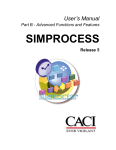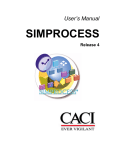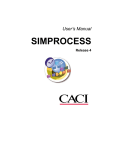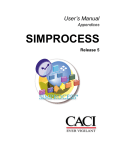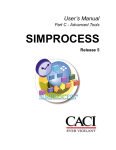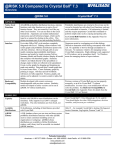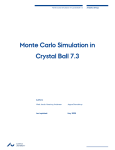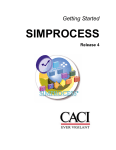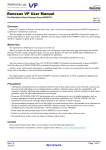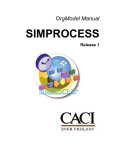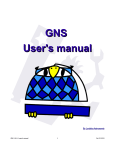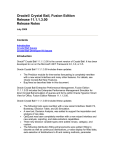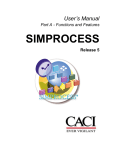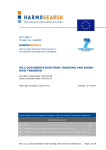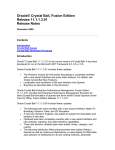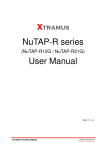Download SIMPROCESS and Dispatcher
Transcript
®
SIMPROCESS
and
Dispatcher
SIMPROCESS as a Service
OptQuest® for SIMPROCESS as a Service
SIMPROCESS and Dispatcher
Table of Contents
Introduction ................................................................................................................. 1
SIMPROCESS and Dispatcher Installation ................................................................ 1
Licensing ..................................................................................................................... 1
3.1
The License Server ............................................................................................. 2
3.2
The license.dat File ............................................................................................. 2
4
The RegistryServer Application ................................................................................. 3
4.1.1 Configuring RegistryServer ............................................................................ 3
4.1.2 Running RegistryServer .................................................................................. 4
4.1.3 Running RegistryServer as a Windows Service ............................................. 4
4.1.4 Running RegistryServer as a Server on Other Systems .................................. 6
4.1.5 Shutting Down the RegistryServer Server ...................................................... 6
5
Dispatcher ................................................................................................................... 7
5.1.1 Locating a RegistryServer............................................................................... 7
5.1.2 Resetting or Appending Dispatcher Log Files ................................................ 8
5.1.3 Dispatcher Debugging .................................................................................... 8
5.1.4 Locating a License Server............................................................................... 8
5.1.5 How Many Dispatchers? ................................................................................. 8
5.1.6 Application or Server? .................................................................................... 9
6
DispatcherService ..................................................................................................... 11
6.1
Installed DispatcherService Components ......................................................... 11
6.2
Configuration Options ...................................................................................... 12
6.2.1 Locating the RegistryServer ......................................................................... 12
6.2.2 Other Property Settings ................................................................................. 12
6.2.3 Changing Properties after Starting DispatcherService ................................. 14
6.3
Deploying the DispatcherService ..................................................................... 14
6.4
DispatcherService Operations ........................................................................... 15
6.4.1 DispatcherService Usage Scenarios .............................................................. 15
6.4.2 Available DispatcherService Operations ...................................................... 17
7
Client Applications ................................................................................................... 48
8
Windows 8 Issues ..................................................................................................... 48
Appendix A - Error Numbers and Descriptions ............................................................... 50
Appendix B - SimulationStatus Source Listing ................................................................ 54
1
2
3
i
SIMPROCESS and Dispatcher
1 Introduction
SIMPROCESS® has a proven track record in its role as a modeling and simulation tool.
More and more often, however, it’s useful to be able to call on simulation capabilities and
use the results to make automated business decisions. SIMPROCESS can now provide
that capability through the DispatcherService, a Web service that can be deployed in a
Web Container (an application supporting the Java Servlet Specification) or Application
Server, and the SIMPROCESS Dispatcher. This document provides details on the
components required to use this capability.
2 SIMPROCESS and Dispatcher Installation
In order to use the Dispatcher and related features, an alternate install set is offered by the
installer, called “SIMPROCESS and Dispatcher.” This is not the default set and must be
specifically selected. It provides all the components needed to use SIMPROCESS as a
regular desktop application, but it also includes new components which allow use of the
Dispatcher to invoke SIMPROCESS services. The key additions are described here.
• Dispatcher is the new program (it will have the .exe extension on Windows
systems) that controls the operation of one or more instances of SIMPROCESS or
OptQuest for SIMPROCESS when requests arrive from the DispatcherService.
• dispatcher is the directory containing all of the other components needed to run
SIMPROCESS services (including the DispatcherService deployment files). Its
precise contents will vary according to the platform on which installation occurs.
More detailed information on some of these components will appear later to
explain their configuration and operation.
Installation is but one of the steps that enable SIMPROCESS or OptQuest for
SIMPROCESS to operate as services. The DispatcherService, included among the
components in the new dispatcher directory, will be described in detail later. It is the
gateway through which a client application obtains SIMPROCESS services. A Web
Container or Application Server will be required in order to deploy and use the
DispatcherService. A client application must be available that knows how to
communicate with the DispatcherService. A Dispatcher must be able to advertise that its
services are available to a DispatcherService. The DispatcherService must know where
to look for the list of service providers. And finally, a Dispatcher must be able to obtain
licenses when services are requested.
The next section provides information on licensing for the Dispatcher. The remaining
sections provide information on the configuration and operation of all other components.
3 Licensing
The licensing of SIMPROCESS as a desktop application is described in Chapter 2 of the
SIMPROCESS Getting Started manual. SIMPROCESS can still be used that way with
the additional Dispatcher-related components installed (although running it at the same
time that the Dispatcher is responding to requests is not recommended). The Dispatcher,
however, is designed to operate as a server application which can start as many instances
1
SIMPROCESS and Dispatcher
of SIMPROCESS or OptQuest for SIMPROCESS as it is licensed to support. For that
reason, its licenses must be served by a FlexNet Publisher license server.
3.1 The License Server
The components required to set up and operate a FlexNet Publisher license server are not
included with the installer. Instead, they will be provided separately by your
SIMPROCESS technical support team. This gives you the flexibility to decide where
you want to place your license server.
Although license servers are available for a variety of platforms (combinations of
operating systems and processors), it is only possible to serve SIMPROCESS licenses on
a platform for which SIMPROCESS itself is available. All binary files required for a
license server can be downloaded from Flexera Software except for our “vendor daemon”
program, dcacisim, and we can only compile it for those platforms on which we currently
offer SIMPROCESS. However, it is possible to mix and match among these platforms to
suit your needs. That is, you might wish to run the Dispatcher on a Linux system (where
performance will often be significantly better than on Windows) and place your license
server on a Windows platform. Or you may wish to run multiple Dispatcher installations,
perhaps even on mixed platforms, sharing a pool of licenses from a single license server.
The available options provide you with greater flexibility and control over distribution of
the workload. Your SIMPROCESS technical support team will help you choose a license
server strategy that best suits your operational needs.
3.2 The license.dat File
The Dispatcher application must obtain a license before it can launch an instance of
SIMPROCESS or OptQuest for SIMPROCESS when services are requested. The
information on how to contact the license server is contained in a license file that must
reside in the dispatcher directory. It should be a copy of the license.dat file used by the
license server, and it must also have that name.
To obtain a license file, you must provide the SIMPROCESS Help Desk with the hostid
value of the system on which your FlexNet Publisher license server will run. If the
license server will be on the same operating system as your Dispatcher, you can use the
hostid.bat or hostid.sh included in the root of the SIMPROCESS installation directory to
put this value into the hostid.txt file. If not, the Help Desk can provide you with a copy
of the lmutil program for the license server’s particular platform and instructions on how
to have it put your hostid value in a file that you can send to them to obtain a license file.
Once you’ve received the license.dat file, you’ll need to know that only one portion of its
contents can be edited without invalidating the contents. The first line of the file will
look something like the following sample:
SERVER 192.168.30.30 0060970572a5
2
SIMPROCESS and Dispatcher
First is the keyword SERVER, which must never be changed. The last part will be the
hostid value that was provided to the Help Desk to obtain the license file; it must also
never be changed. The middle part, however, is the Internet Protocol (IP) address of the
system on which the license server is to run. Because network configurations sometimes
change, this value can be changed if required. If possible, however, it’s usually a best to
use a name in this position (e.g., myhost.mycompany.com) rather than an actual
numerical IP address, and ensure that all installed Dispatcher applications communicating
with this license server can resolve the name to the correct machine. On the server itself,
it’s allowable to replace the IP address with the keyword this_host, which eliminates the
need to change the file should the system’s IP address change. If the license server will
reside on the same system as a Dispatcher, then that Dispatcher’s license.dat file may
also use the this_host keyword. Any other changes in the license file will render it
invalid and the Dispatcher will be unable to obtain licenses to run SIMPROCESS
instances.
4 The RegistryServer Application
The RegistryServer is the smallest piece of the complete puzzle, but without it nothing
else will work. The RegistryServer is the means by which a Dispatcher advertises that its
services are available. It’s the means by which a DispatcherService locates available
Dispatchers to obtain SIMPROCESS services. It provides a registry – a place where
other things can deposit and look up information. Therefore, the RegistryServer must be
running in order for any Dispatcher to register itself as an available service provider. In
addition, the DispatcherService must know where it can be found so that it can obtain a
list of available service providers. Later sections contain further configuration details for
those components.
4.1.1 Configuring RegistryServer
The registry.properties file must be in the same directory with dispatcher.jar for proper
operation. In most situations, the original contents of this file will work properly on any
system without changes, but it may be necessary to modify specific entries.
• The line “java.naming.provider.url=rmi://localhost:5700” should only be changed
if port 5700 is in conflict with another application on the network. This port was
selected because it is not reserved for use by any well known network service. If
it is necessary to change this port, it’s important that the same value be used in the
properties files for both the Dispatcher and the DispatcherService so that both will
know how to find the RegistryServer application. Do not change any other
portion of this line.
• The line “#registry.logging=true” should not normally be enabled. However, if
there is a significant problem with network communications, enabling this line by
removing the “#” will cause RegistryServer to log all communications. This will
produce a large amount of output, so it should only be done if absolutely essential.
Enabling this line while RegistryServer is running will not enable logging.
• The line “log.reset=true” will instruct RegistryServer to reset its log and error file
when starting, rather than appending to any existing contents. This line can be
removed, or it may be disabled by placing a “#” character at the beginning. When
any value other than “true” is found, the log and error output will be appended to
3
SIMPROCESS and Dispatcher
•
any existing information in the files. Changing this setting will require stopping
and restarting RegistryServer.
The line “#registry.debugging=true” can be enabled by removing the “#” at the
beginning if debugging output is desired. This is normally not required except
perhaps during initial deployment testing. In normal usage (i.e., with this line
disabled), there will be very little output placed into the log and error files. When
enabled, some of the internal logic will display information into the log file about
calls received and information provided in response. Enabling this line while
RegistryServer is running will not enable debugging output.
4.1.2 Running RegistryServer
The RegistryServer application is specifically designed not to depend on any particular
hardware or operating system. It only requires that the system on which it runs has a Java
Runtime Environment (JRE) that is fully compatible with Sun’s Java 6.0 (also called Java
1.6) or newer. Therefore, it does not have to be run within the confines of the
SIMPROCESS directory structure, and it may be hosted on any available system with a
compatible JRE. The installer provides the files RegistryServer.sh and
RegistryServer.bat in the dispatcher directory, which are preconfigured examples of how
to run it using the JRE installed with SIMPROCESS. These can be used as examples for
running RegistryServer on any system with a compatible JRE. To run RegistryServer, its
two required files must be in the same directory:
• dispatcher.jar
• registry.properties
RegistryServer has been tested on Windows XP Professional, Windows 2003 Server,
Windows 7, Windows 8, Linux Mandrake 9.1 and Mandriva Linux 2009. All were tested
with a JRE obtained from Oracle (http://www.oracle.com/technetwork/java/index.html).
4.1.3 Running RegistryServer as a Windows Service
It will usually be preferable to run RegistryServer so that it requires no user intervention.
That is, it should be able to start up and run automatically without a user session being
kept active to support it. On Windows systems, this can be accomplished by installing it
as a Windows Service.
The “SIMPROCESS and Dispatcher” install set will include all the files needed to do this
(even if installing on a non-Windows platform). If you wish to install RegistryServer as a
Service on a Windows system other than the one on which the Dispatcher will operate,
the files described in the following paragraphs will need to be copied to the same
directory as the dispatcher.jar and registry.properties files described above, though one
of them will require additional changes to be made. Here are the files provided, along
with instructions on their use.
4.1.3.1 RegistryService.exe
This executable file will install the Windows Service using parameters passed to it by the
RegistryServiceInstall.bat file.
4
SIMPROCESS and Dispatcher
4.1.3.2 RegistryServiceInstall.bat
This batch file executes the RegistryService.exe program and passes parameters that will
cause it to install a Service named “SIMPROCESS RegistryService” that will start
automatically each time your system starts up. As initially provided by the installer, it
will only work correctly when run from the dispatcher directory of SIMPROCESS. To
install RegistryServer as a Service on another Windows system, this file must be edited.
The seven steps defined in comments in the original will serve as the basis for explaining
what changes must be made there.
• Steps 1 and 2 are used in the installed SIMPROCESS setting to obtain the
complete directory name where SIMPROCESS was installed. These can be
removed in a copy to be used on another system. Alternatively, you can change
either or both of them to provide information required in later steps.
• Step 3 sets the variable JVMLoc to the complete path of a file named jvm.dll
included with the JRE for running RegistryServer. For the modified copy of this
file, change this line to provide the full path to that file in the JRE to be used. For
example, if the system contains Oracle’s Java Plug-in for use with applets in web
browsers, there will be a JRE included in it. The complete path on a typical
system might be C:\Program Files\Java\jre7\bin\client\jvm.dll. It’s also
important to note that a path containing spaces (like this one does) must be
enclosed in quotes. So the resulting line might look like this:
set JVMLoc="C:\Program Files\Java\jre7\bin\client\jvm.dll"
•
Step 4 sets the variable WorkDir to the path of the “working directory” where
RegistryServer will run. This will allow it to find its registry.properties file, and
is where its log and error files will be created (named DispatcherRegistry.log and
DispatcherRegistry.err). Just as with JVMLoc, this requires quotes if any spaces
appear in the name (they are allowed even if there are no spaces). The directory
can be any place you choose, so the command might look like this:
set WorkDir="D:\work\registryserver"
•
•
The remaining steps must not be changed. Note Step 6, however, which actually
installs the new Service using the name “SIMPROCESS RegistryServer.” If no
problem occurs, the system will display a message saying that the installation of
the new Service was successful. Step 7 then reminds you that the newly installed
Service must be started, or that it will start automatically upon restarting your
system.
To start the new Service once installation is accomplished, you can go to the
Windows Control Panel and select Administrative Tools, then Services. Select
the Service to start or stop it as needed.
4.1.3.3 RegistryServiceUninstall.bat
This batch file uninstalls the Windows Service named “SIMPROCESS RegistryService.”
It will fail if the Service is currently running. No changes to this file will be required. It
must reside in the same directory with RegistryService.exe.
5
SIMPROCESS and Dispatcher
4.1.4 Running RegistryServer as a Server on Other Systems
Java programs have a tendency to shut themselves down when any kind of user logoff
action occurs. As a result, RegistryServer couldn’t simply be run as a Scheduled Task in
Windows since it would terminate if any user logged off the system at the completion of
some task. A similar problem can arise on Unix-based systems (which includes Linux,
Mac OS X, and many others), so that simply running the program in the background by
appending an ampersand (“&”) to the command will not necessarily work. Here are two
alternatives which might be useful to deal with this issue when running RegistryServer on
these systems.
• Use the nohup command. This is usually done by preceding the command with
the word “nohup” and following it with an ampersand to put it in the background
(for example, nohup ./RegistryServer.sh &). When using nohup, a program will
not stop when the user logs off the system (“hangs up”). Instead, it continues to
run in the background. This may not be an ideal solution, however, depending on
the method used to connect to the system, as it sometimes prevents proper
termination of X-server sessions or has other undesirable side effects. It will also
require that you repeat the process after a system restart.
• Add the appropriate command to a system startup file. (Precise details will vary
with the operating system.) Some Linux systems, for instance, look for a file
named /etc/rc.d/rc.local to be executed during the system startup process. Putting
an entry here to start the RegistryServer will ensure that it’s run every time your
system starts, which guarantees that it will be available. So you might make an
entry that will run a shell script or Java command line as a non-privileged user
(i.e., a user other than root – you should never use root for such purposes)
something like this:
/bin/su username -c "cd dirname;./scriptname.sh"
4.1.5 Shutting Down the RegistryServer Server
Sometimes you’ll want to shut down the RegistryServer without shutting down the entire
system. If you installed your RegistryServer as a Windows service, instructions are
provided above for shutting it down. If you’ve set it up to run as a server on a nonWindows system, read on. In either case, it’s wise to ensure that any Dispatchers which
refer to it are shut down first. Shutting them down lets them remove their entries from
the RegistryServer and clean up, rather than being orphaned and shutting down due to a
communication failure.
When shutting down RegistryServer on Unix-based platforms, you’ll want to understand
the proper (and safe) method of shutting it down. The key is to find the first “java”
process in the set of processes that were created by starting it. Look at a detailed process
list using a form of ps appropriate to the operating system and trace the Process ID (PID)
values to find the first one in the chain. If you’ve used a shell script file, you’ll want to
use the first “java” process owned by it and not the PID of the shell command itself.
Now you need to stop that process with the kill command and an appropriate signal.
Many signals will either have no effect, or may result in an improper (and thus unsafe)
6
SIMPROCESS and Dispatcher
shutdown. To ensure that RegistryServer is able to shut down cleanly, you should always
use SIGINT, which is an interrupt signal. If RegistryServer.sh were run from a command
line, using the Ctrl+C key combination delivers a SIGINT to the program, which lets it
shut down cleanly. Sending SIGINT with the kill command does the same when it’s in
the background. You may need to use man kill to learn the appropriate form of the kill
command to use on your particular system.
5 Dispatcher
The Dispatcher has previously been addressed in terms of licensing, but that omitted the
details of its configuration and operation. Now it’s time to fill in those details.
5.1.1 Locating a RegistryServer
As was noted earlier, the RegistryServer is a critical part of providing SIMPROCESS or
OptQuest for SIMPROCESS services. A Dispatcher must be able to communicate with a
RegistryServer on startup to list itself as a provider of SIMPROCESS services. Its
configuration must tell it where to find a RegistryServer, and it must be able to
successfully communicate with it in order to function. If it cannot do so, it will shut itself
down. The information required to locate a RegistryServer is found in the file named
dispatcher.properties, which the installer places in the dispatcher directory. This file
must always be in this directory. Here is the portion of the installed file that tells a
Dispatcher how to find its RegistryServer:
#
# Naming provider URL
# If RegistryServer is not running at port 5700, change the port number
# in the line below to match.
#
# Determine the hostname or IP where RegistryServer is running if not
# on the same system with the Dispatcher and replace "localhost" with
# that value.
#
java.naming.provider.url=rmi://localhost:5700
Much of this is comment text explaining what the property must contain. There are only
two specific parts that can be changed without rendering the file useless: (1) localhost
and (2) 5700. The first item, localhost, is a universal name which refers to the same
computer on which the Dispatcher application is running. If RegistryServer is running on
the same system as the Dispatcher, this value can remain unchanged. If not, it should be
changed to an IP address or to a name that the system can resolve to the IP address of the
system where RegistryServer is running (e.g., myhost.mycompany.com). The second
item is the network port over which communication will occur between the Dispatcher
and RegistryServer applications. This should only be changed if the port for
RegistryServer was changed in its registry.properties file.
Important: The Dispatcher requires a RegistryServer to be reachable upon startup.
Therefore, if a RegistryServer cannot be reached using the values in this properties file
when starting up, it will shut down immediately and record the trouble in its output
file(s). Always make sure the RegistryServer is available before starting the Dispatcher.
7
SIMPROCESS and Dispatcher
5.1.2 Resetting or Appending Dispatcher Log Files
The dispatcher.properties file contains a line which reads “log.reset=true” which governs
whether the Dispatcher.log and Dispatcher.err files will be reset or whether any existing
content will be appended to when the Dispatcher starts. As initially set, the Dispatcher
will clear any existing content in these files at startup. If this line is removed, disabled by
placing a “#” at the beginning, or contains any value other than “true” then the existing
content will remain and new output will be appended to it.
5.1.3 Dispatcher Debugging
Only one other property in the dispatcher.properties file should ever be changed. The
last line in the installed file reads “#dispatcher.debugging=true” and should ordinarily be
left alone. However, if additional information is desired in the Dispatcher’s log and error
files (or its window when running the application directly, as described later), the “#” can
be removed at the beginning to enable debugging output. This puts a significant amount
of output into the log and error files (Dispatcher.log and Dispatcher.err) that is primarily
only useful to developers. Enabling it is not generally recommended.
5.1.4 Locating a License Server
A Dispatcher does not depend upon being able to communicate with a license server at
initial startup. However, it must be able to check out a license when asked to provide
SIMPROCESS services. If it cannot, it is unable to render the requested services and
responds accordingly. For a Dispatcher to provide services, it must (1) be able to
communicate with the license server identified in its license.dat file, and (2) the license
server must have an available license when requested. If it cannot contact the license
server, or if the server is unable to grant a license request for any reason, then the
Dispatcher will reply that it is unable to provide the requested services.
5.1.5 How Many Dispatchers?
It is possible to run more than one Dispatcher from a single SIMPROCESS installation.
However, because of the way that each one writes to its log and error files, this would
result in sharing of files and is generally not recommended. On a limited basis, it may be
useful for initial testing, but should otherwise be avoided.
To run more than one Dispatcher on a single computer system, install multiple copies of
SIMPROCESS. Each Dispatcher will have its own properties file, and each will write to
separate log and error files, eliminating any potential conflicts. Each must also have its
own license.dat file to enable it to communicate with a license server.
Windows systems typically don’t perform sufficiently well to make multiple installations
practical, but Linux systems are ideal for such purposes. They tend to do much better at
memory management and are better suited to running large numbers of applications
simultaneously. If a Windows system is to host multiple Dispatchers, it should have the
fastest possible processor and the maximum possible amount of RAM per licensed
SIMPROCESS feature. In addition, if run as a Service (see below), there may be special
considerations needed in setting up each one.
8
SIMPROCESS and Dispatcher
5.1.6 Application or Server?
There are two distinct ways to run a Dispatcher. One is as an application, where a user
starts the program and it shows a window. The other is as a server, where the program
runs without user interaction and will typically be able to run with no user logged on.
5.1.6.1 Application
To run the Dispatcher as an application, first make sure that all previously mentioned
criteria have been met. That is, make sure that the required information is provided to
communicate with a license server and RegistryServer as needed. Then run the
Dispatcher program found in the root of the SIMPROCESS installation directory. When
run in this way, the Dispatcher will display a window. This window will display a
message at startup indicating the internal name by which it will be known (this name is
only meaningful to the RegistryServer). During Dispatcher operations, it will display
occasional messages indicating that it has received and responded to requests for
services. (There will be much more information in this window and the log and error
files if debugging is enabled.) Running a Dispatcher as an application can be useful for
becoming familiar with how it works, for testing situations where multiple Dispatchers
may be helpful, or a variety of other purposes. A Dispatcher run in this manner can be
shut down by using its File menu, or simply by closing its window. When this occurs, it
will prompt for confirmation if any SIMPROCESS or OptQuest for SIMPROCESS
instances are still running. Instances must periodically confirm that they can still
communicate with their owning Dispatcher and will shut down when that fails. A
Dispatcher controls the licenses it checks out, so its termination frees all licenses it holds
and leaves instances without valid authorizations.
5.1.6.2 Server
The most common use of a Dispatcher will be in a setting where it can run with no user
interaction (i.e., no user session is needed) and it will not be hampered by users logging
on to perform some task and then logging off again. Just how this is accomplished will
depend on the platform where it will be running.
5.1.6.2.1 Running Dispatcher as a Windows Service
When installed on a Windows system, the dispatcher directory contains files that allow
the installation of a Windows Service that will automatically run each time the system is
booted. These files are described below.
• DispatcherServer.exe is the executable program which installs a Windows Service
named “SIMPROCESS Dispatcher” using the additional parameters provided by
a batch file.
• DispatcherServerInstall.bat is a batch file that executes DispatcherServer.exe and
provides it the necessary parameters.
• DispatcherServerUninstall.bat is a batch file that executes DispatcherServer.exe
to uninstall the previously installed Windows Service named “SIMPROCESS
Dispatcher.” Note that the service must be stopped before it can be successfully
uninstalled.
These files must remain in the directory where they are installed. Only the file named
DispatcherServerInstall.bat should ever be modified in any way, and then only under
9
SIMPROCESS and Dispatcher
certain conditions. Specifically, if the Dispatcher is to run as a Service on the same
system where a “SIMPROCESS RegistryServer” will also be installed, it’s advantageous
to change this file so that a dependency is established between the two. To do that, find
the following lines in the DispatcherServerInstall.bat file:
REM If dependency on the SIMPROCESS RegistryServer service
REM is desired, uncomment the following line.
REM set DEPENDS=-depends "SIMPROCESS RegistryServer"
On the last of those lines, remove the “REM” and the space which follows it, then save
the modified file. This will cause the new Service named “SIMPROCESS Dispatcher” to
be dependent on the “SIMPROCESS RegistryServer” so that the latter will automatically
start if it’s not running.
Now simply double-click the batch file to install the Service. A reminder will appear
stating that you’ll need to start the Service manually unless you wish to restart your
system. To start manually, use the Windows Control Panel and choose Administrative
Tools, then Services. In the list of Services, select the “SIMPROCESS Dispatcher” and
start it. If the dependency is set, this will also start “SIMPROCESS RegistryServer” if
necessary.
5.1.6.2.2 As a Server on Other Systems
As stated earlier, Java programs have a tendency to shut themselves down when any kind
of user logoff action occurs. So on Unix-based platforms, simply running the Dispatcher
in the background by appending an ampersand (“&”) to the command will not work.
Here are two alternatives which might be useful for running Dispatcher as a server on
these systems.
• Run using the nohup command. This is usually done by preceding the command
with the word “nohup” and appending an ampersand to put it in the background
(e.g., nohup ./Dispatcher svc &). When using nohup, a program will not stop
when the user logs off the system (i.e., “hangs up”). Instead, it continues to run in
the background. This may not be an ideal solution, depending on the method used
to connect to the system, as it sometimes prevents proper termination of X-server
sessions or has other undesirable side effects. It will also require manually
starting the Dispatcher via the nohup command any time the system restarts.
• Add the appropriate command to a system startup file. (The precise details will
differ according to the actual operating system.) Some Linux systems, for
instance, look for a file named /etc/rc.d/rc.local that will be executed during the
system startup sequence. So you might make an entry that will run a shell script
as a non-privileged user (i.e., a user other than root – you should never use root
for such purposes) like this:
/bin/su username -c "cd installdir;sh Dispatcher svc"
Remember that the earlier discussion of running a Dispatcher as an application said that it
displays a window for user interaction. Clearly, that is not a good thing when running as
a server. For that reason, the Dispatcher is designed to alter its behavior when receiving a
10
SIMPROCESS and Dispatcher
command line parameter. In the two examples shown above, a parameter value of svc
was included on the command line. This signals to the Dispatcher that it is being run as a
server and suppresses the creation of its window. Failure to include this parameter will
not produce the desired results.
Important Note: When placing entries in system startup files for both a RegistryServer
and one or more Dispatchers on one system, be sure to start the RegistryServer first so
that each Dispatcher will be able to communicate with the RegistryServer.
There may be times when it’s necessary to shut down such a Dispatcher without shutting
down the entire system. There are two methods that may be used.
• Shut down the RegistryServer on which the Dispatcher depends. Each Dispatcher
periodically checks to determine if its RegistryServer is available. If it is not able
to communicate with its RegistryServer, it will shut down. This may not be a
good choice if more than one Dispatcher uses the same RegistryServer. Since the
RegistryServer may not reside on the same system (perhaps not even the same
operating system) where a Dispatcher runs, refer to the appropriate instructions
for how to shut it down.
• The preferred way to shut down a Dispatcher running as a server is to identify its
Process ID (PID) number and use the kill command. Only send the signal called
SIGINT, since any other will either be ignored or may not allow the Dispatcher an
opportunity to properly clean up (by removing its entry from the RegistryServer,
for instance). Finding the right PID can be a little tricky, and the precise form of
the ps command needed can vary among operating systems. When started with a
command like the example shown above, look for processes whose command
lines include the complete path to the installed JRE’s “java” command (e.g.,
/installdir/jre/bin/java) followed by “com.zerog.lax.LAX”. Select the first PID in
the sequence and send it a SIGINT to interrupt it. You may want to use man kill
to determine the correct form of the command for your system. The Dispatcher
will then shut down just as if it had been running as an application with a window
and the File menu was used to stop the program.
6 DispatcherService
The DispatcherService is the gateway to SIMPROCESS services for client applications.
Naturally, it will need to know about a RegistryServer to get a list of service providers.
And it will communicate with a Dispatcher registered there to obtain the services. But all
that is the magic behind the curtain. The client, generally speaking, will only know about
the DispatcherService. It will never interact directly with the other players. This section
tells you how to put the DispatcherService to work for a client.
6.1 Installed DispatcherService Components
In the dispatcher directory is a subdirectory named DispatcherService. It contains the
components you must deploy to provide SIMPROCESS services to client applications.
The files installed are listed below.
• DispatcherService.wsdl is the Web Services Description Language (WSDL) file
which describes the operations available from the deployed DispatcherService
11
SIMPROCESS and Dispatcher
•
•
•
Web service. It’s not necessary to have this file to deploy the service, since you’ll
be able to obtain one from your Web Container or Application Server, but for the
technically curious who want a head start, it can help in planning for the
development of a client application.
DispatcherService_schema1.xsd is the XML Schema file which is referenced in
the above WSDL file.
DispatcherService.war is a Web Archive (WAR) file containing the complete,
deployable DispatcherService. It was developed in Java using Oracle’s Java APIs
for XML-Based Web Services (JAX-WS). This isn’t critical to know for a client
application developer, but technical people may recognize some of the WSDL and
XML Schema file contents more readily once they’re aware of this fact.
dispatcherservice.properties is a properties file similar to those used by both the
Dispatcher and RegistryServer programs. It must be deployed along with the
WAR file so that the DispatcherService can find the location of a RegistryServer
to obtain a list of service providers, along with some other configuration options
described in the next paragraph.
6.2 Configuration Options
The dispatcherservice.properties file contains five items which can be set to affect its
operation.
6.2.1 Locating the RegistryServer
Just as with a Dispatcher, the DispatcherService must be able to find a RegistryServer
that has a list of service providers (Dispatchers). The properties file contains an entry for
this purpose, which initially appears as follows:
#
# Naming provider URL
#
Determine the hostname or IP where RegistryServer is
#
running and use that instead of localhost.
#
If this property in the RegistryServer's properties
#
file is not using port 5700, change the port value
#
below to match its value.
#
java.naming.provider.url=rmi://localhost:5700
Only if the RegistryServer has used a port number other than 5700 in its own properties
file should that portion of this property be changed. The hostname localhost should
remain only if the RegistryServer is on the same system as the Web Container or
Application Server where you’ll deploy the DispatcherService. Otherwise, you should
change it to an IP address or hostname that will locate that system on the network.
6.2.2 Other Property Settings
The dispatcherservice.properties file contains a comment block indicating that all items
below it are configurable by the individual responsible for configuring and deploying the
DispatcherService. With the exception of the single item above, nothing else above this
comment block should be changed in any way. Here are the remaining configurable
properties and their uses.
12
SIMPROCESS and Dispatcher
#
# Default timeout of instance in minutes.
#
instance.timeout.default=2
Must be positive.
The default instance timeout is the default amount of time that can elapse without
commands being sent to a SIMPROCESS or OptQuest for SIMPROCESS instance
(known as an optimizer) before it will be considered idle. When an instance is started by
a client application sending an appropriate message to the DispatcherService, it will use
the timeout value provided if allowed. If the value provided is non-positive or greater
than the maximum (see below), this default value will be used instead. Each time the
DispatcherService’s timer fires, it will identify any instance deemed idle and ask its
Dispatcher to shut it down, thereby freeing a license. If the instance is running a
simulation or actively carrying out some other long-running request, it will reject the
request to shut down. It’s best to use a relatively small default timeout value to prevent
the possibility of an idle instance needlessly tying up a license.
#
# Maximum timeout of instance in minutes.
#
instance.timeout.max=60
Must be positive.
The maximum instance timeout is the largest timeout value that can be used when
starting an instance or by sending a message to set an instance’s timeout value. If any
message includes a timeout value larger than this, that value will be discarded and this
one used instead. This is useful to prevent an idle instance from unnecessarily tying up a
license.
#
# Timer interval for checking timeouts (in minutes).
# Must be positive.
#
timer.interval=2
This property determines how frequently the DispatcherService’s internal timer will fire.
Each time it fires, its list of instances will be checked to determine which ones have not
had any messages delivered for a sufficient period of time to exceed their timeout limits.
When one is found, its Dispatcher will be asked to shut it down. If it’s actively engaged
in receiving another command or simulating, the command to shut down will be
disregarded until the next timer firing occurs. If it responds that an error has occurred, its
Dispatcher will be asked to forcefully shut it down. Setting too small a value for this
property can result in too many requests for instance shutdown, thereby risking the
integrity of communications with any given Dispatcher. Using too large a value can
result in extended idle times that needlessly tie up licenses.
13
SIMPROCESS and Dispatcher
#
# Debugging (should normally be disabled)
#
#service.debugging=true
The service.debugging property is initially disabled. To enable it, remove the “#” from
the beginning of the line. When enabled, the DispatcherService will write output into the
standard output and standard error files of the Web Container or Application Server
where it operates. The names and locations of those files depend on the product being
used. When debugging has been enabled, the service will display an indication when it’s
loaded for the first time as it constructs its timer, including displaying its timer interval.
It will also display messages at the start of its timer logic and then again at the end, along
with possible messages in between if it finds timed out instances and sends messages to
have them stopped.
6.2.3 Changing Properties after Starting DispatcherService
The DispatcherService reads its properties once when initially loaded by the Web
Container or Application Server where it’s deployed. If it becomes necessary to change
any of the properties in this file after loading, the service usually must be stopped and
restarted in order to have it read the newly modified file. The specific mechanism for
starting, stopping or restarting a Web service depends on the particular Web Container or
Application Server used, as do the details of where the dispatcherservice.properties file
should be placed.
6.3 Deploying the DispatcherService
The DispatcherService.war file is self-contained (except for the properties file described
above) and ready to deploy into a suitable Web Container or Application Server. The
selected Web Container or Application Server must include support for the following
technologies:
• Java Servlet 2.3 specification or later
• Java API for XML-Based Web Services (JAX-WS) 2.1 or later
Sun’s Java Standard Edition (Java SE) 6 (also known as Java 6.0 or Java 1.6) update 14
or later will meet the JAX-WS requirements. A Web Container or Application Server
supporting the J2EE 1.4 specification will likely meet the servlet requirements.
Development and testing of DispatcherService is primarily done using the Apache
Tomcat servlet container. While others support the required technologies and may be
used, this is the only one which will be described in greater detail here. Installing Tomcat
5.5 with a Java 6 or 7 Development Kit (JDK) will provide all the required features.
Once Tomcat 5.5 is installed and configured, you will need to deploy the
DispatcherService.war and dispatcherservice.properties files. Tomcat includes a
“Manager Application” that can be used to stop, start, deploy or undeploy Web services
and applications, including uploading WAR files for deployment. The Tomcat
documentation also designates the location of “resources” needed by a service or
application which aren’t already built into it. The dispatcherservice.properties file is
14
SIMPROCESS and Dispatcher
such a resource and must be placed in the <Tomcat-installDir>/shared/classes directory
in order to be found by the DispatcherService when it initially loads.
6.4 DispatcherService Operations
Precise details on the use of the DispatcherService to obtain SIMPROCESS services will
vary based on numerous factors, including the Web Container or Application Server
chosen for its deployment and the nature of the client application. Client applications
might take the form of JavaServer Pages (JSPs). They could be Web services
themselves. Or they might be standalone programs written in any of a variety of
programming languages. That’s a key reason that the WSDL and XML Schema files,
describing the DispatcherService in a way that is meaningful to application developers
and their tools, is included among the installed files.
Equally important is an understanding of how the available operations might be applied
to get the benefits of using SIMPROCESS simulation services on demand. So before
listing the available operations, let’s first look at some scenarios outlining how they
might be used to satisfy the needs of a client application.
6.4.1 DispatcherService Usage Scenarios
A list of available operations will be more meaningful if they can be understood as a set
of actions needed to satisfy a business requirement. The scenarios that follow describe
some situations in which simulation services are important to a business process and
show how SIMPROCESS can be used on demand to can satisfy that need. Each will
generically present a situation, followed by a series of steps which can be taken to obtain
SIMPROCESS or OptQuest for SIMPROCESS services via DispatcherService. Each
step will provide the name in italics of one or more operations which will be described in
greater detail in the next section listing available operations. These scenarios leave out
the handling of error conditions, which would be essential activities in a client
application. Note that the steps for starting and handling a SIMPROCESS instance are
different from the steps for starting and handling an OptQuest for SIMPROCESS
optimizer.
6.4.1.1 Scenario 1
A client application which monitors ongoing activities in a business process needs to
respond to certain infrequent events by simulating a model using SIMPROCESS. The
operations called on by the client application might be:
• Request the start of a SIMPROCESS instance, optionally providing a positive
timeout (startInstance)
• Ask the instance to open a model (openModel)
• Ask the instance to set some parameters in the model (setModelParameters)
• Ask the instance to begin simulating the model (startSimulation)
• Check periodically until the simulation is complete (isSimulationComplete or
getSimulationStatus)
• Optionally close the model (closeModel)
• Stop the instance (which will close any open models), or allow the timeout to
expire if it is reasonably short, to free the license (stopInstance)
15
SIMPROCESS and Dispatcher
6.4.1.2 Scenario 2
At specific timed intervals, an application needs to simulate a model and provide results
to users. The operations called on by the client application might be:
• Request the start of a SIMPROCESS instance (startInstance)
• Set the timeout on the instance to the maximum allowable value, so that the
license is not released to other client applications (getMaxTimeout, setTimeout)
• Ask the instance to open a model (openModel)
• Ask the instance to set some parameters in the model (setModelParameters)
• Ask the instance to begin simulating the model (startSimulation)
• Check periodically until the simulation is complete (isSimulationComplete or
getSimulationStatus)
• Repeatedly set parameters, simulate the model, and check status as needed based
on some business rules in the client application (setModelParameters,
startSimulation, isSimulationComplete or getSimulationStatus)
• At application shutdown, stop the instance (which will close any open models)
and free the license (stopInstance)
6.4.1.3 Scenario 3
An interactive, Web-based client application needs to pass some of the user-entered data
to a model to use as parameters and simulate. Once simulation completes, it needs to
report to users the results of the simulation when available, after which they may elect to
modify their entries and repeat the simulation process. Once the user has entered all
client-edited information, the operations called on by the client application might be:
• Request the start of a SIMPROCESS instance (startInstance)
• Ask the instance to open a model (openModel)
• Ask the instance to set some parameters in the model, using data entered by the
user (setModelParameters)
• Ask the instance to begin simulating the model (startSimulation)
• Check periodically until the simulation is complete (isSimulationComplete or
getSimulationStatus)
• Stop the instance (which will close any open models) and free the license
(stopInstance)
6.4.1.4 Scenario 4
At certain times a SIMPROCESS model needs to be run to determine optimal results for
users:
• Request the start of an OptQuest for SIMPROCESS optimizer (startOptimizer)
• If there is more than one optimization defined in the model, or none is designated
as the active one, select the optimization definition to use (setOptimization)
• If necessary, modify the optimization definition (setDecisionVariable,
setConstraint, setMaxIterations, setReplications, setAutoStop, setPrecision)
• Ask the optimizer to begin the optimization (optimize)
• Check periodically until the optimization is complete (isOptimizationComplete)
• Retrieve optimization results (various methods in 6.4.2)
16
SIMPROCESS and Dispatcher
•
Stop the optimizer and free the license (stopOptimizer)
Clearly, many scenarios will take very similar steps to satisfy their requirements. The
powerful features of SIMPROCESS allow tremendous flexibility in reading and writing
databases or taking other actions which facilitate information exchange between the
model being simulated and the client. In the next section, you’ll find a list of all the
operations offered by DispatcherService to implement these actions, as well as proper
error handling, so that a client can take advantage of the full power of SIMPROCESS
simulation services at need.
6.4.2 Available DispatcherService Operations
Because the DispatcherService was developed in Java and uses JAX-WS, the simplest
way to describe the available operations is as Java methods. The paragraphs which
follow will show each available operation as a Java method, along with a brief
description of its purpose and resulting error settings for the service and any affected
SIMPROCESS instance or OptQuest for SIMPROCESS optimizer. Those needing to
know greater levels of technical detail (concerning SOAP message formats, etc.) should
refer to the WSDL and XML Schema files.
6.4.2.1 Say Hello
Method
Description
Error settings
after call
Special
Conditions
Usage Comments
public String sayHello()
Ask DispatcherService to say hello
Service: NOERR (List of errors is in Appendix A)
Instance: N/A
None
6.4.2.2 Check for Error
Method
Description
Error settings
after call
Special
Conditions
Usage Comments
public boolean error()
Determine if DispatcherService error occurred
Service: Not changed
Instance: N/A
None
Mainly useful as a test of successful communication,
returns the literal string "Hello from the
DispatcherService"
Call after most operations to determine if a non-zero
error (any error other than NOERR) exists in
DispatcherService’s error manager.
6.4.2.3 Last Error Number
public int lastError()
Method
17
SIMPROCESS and Dispatcher
Description
Error settings
after call
Special
Conditions
Usage Comments
Get DispatcherService’s last error number
Service: Not changed
Instance: N/A
None
Call after most operations to obtain the current error
number value from DispatcherService’s error manager.
6.4.2.4 Get Error Message
public String getErrorMessage(int error)
Method
Retrieves the text corresponding to the error number
Description
provided.
Service: Not changed
Error settings
Instance: N/A
after call
See the list of errors in Appendix A. If the value
Special
provided is outside the range of valid error numbers, the
Conditions
returned string will contain "Invalid error number."
Usage Comments Call at any time to obtain the text string describing a
particular error number.
6.4.2.5 Get Detail Error Message
public String getDetailErrorMessage()
Method
Retrieves the text of the Detail Error Message set by the
Description
most recent operation. This operation will return the
string set by the most recently called service operation;
if none was set, it returns null.
Service: Not changed
Error settings
Instance: N/A
after call
None.
Special
Conditions
Usage Comments Call after determining that an error at the service has
occurred to see if a more detailed description of the
problem is available.
6.4.2.6 Get Exception Message
public String getExceptionMessage()
Method
Retrieves the Exception message text, if one occurred
Description
during the most recent operation, or a null value.
Service: Not changed
Error settings
Instance: N/A
after call
None.
Special
Conditions
18
SIMPROCESS and Dispatcher
Usage Comments
Call after determining that an error at the service has
occurred to see if an exception resulted and get more
detailed information.
6.4.2.7 Check for Instance or Optimizer Error
public boolean instanceError(String token)
Method
Determine if an error occurred in the most recent
Description
command sent to the SIMPROCESS instance or
optimizer identified by the unique token.
Service: Set to UNKNOWN_INSTANCE if the token is
Error settings
unknown; otherwise NOERR.
after call
Instance: Not changed
This call does not get passed to the specified instance
Special
or optimizer, and therefore does not delay its timeout.
Conditions
Usage Comments Call after most instance or optimizer operations to
determine if a non-zero error (any error other than
NOERR) exists in the instance’s or optimizer’s error
manager. Any time this call returns true, first confirm
that the service’s error number is NOERR and then
check the instance’s or optimizer’s value.
6.4.2.8 Last Instance or Optimizer Error Number
public int lastInstanceError(String token)
Method
Get last error number for the SIMPROCESS instance or
Description
optimizer identified by the unique token.
Service: Changed to UNKNOWN_INSTANCE if the
Error settings
token is unknown; otherwise NOERR.
after call
Instance: Not changed
This call does not get passed to the specified instance
Special
or optimizer, and therefore does not delay its timeout.
Conditions
Usage Comments Call after most instance or optimizer operations to
obtain the current error number value from an
instance’s or optimizer’s error manager. An invalid
token returns UNKNOWN_INSTANCE.
6.4.2.9 Get Instance or Optimizer Error Message
public String getInstanceErrorMessage(String token)
Method
Retrieves the text corresponding to the current error
Description
number of the instance or optimizer identified by the
unique token.
19
SIMPROCESS and Dispatcher
Error settings
after call
Special
Conditions
Usage Comments
Service: UNKNOWN_INSTANCE if token is
unknown; otherwise unchanged.
Instance: Not changed
See the list of errors in Appendix A. This call does not
get passed to the specified instance or optimizer, and
therefore does not delay its timeout.
Call to get the text corresponding to the instance’s or
optimizer’s current error number. Will return null if the
token does not refer to a known instance or optimizer.
6.4.2.10 Get Detail Instance or Optimizer Error Message
public String getDetailInstanceErrorMessage(String
Method
token)
Retrieves the text of the Detail Error Message set by the
Description
most recent operation of the instance or optimizer. This
operation will return the string set by the most recent
operation; if none was set, it returns null.
Service: Set to UNKNOWN_INSTANCE if token not
Error settings
known; otherwise not changed.
after call
Instance: Not changed
This call does not get passed to the specified instance
Special
or optimizer, and therefore does not delay its timeout.
Conditions
Usage Comments Call after determining that an error occurred in most
recent operation of the instance or optimizer referred to
by token; null will result if the service does not know
the token or if no value has been set by the instance or
optimizer.
6.4.2.11 Get Instance or Optimizer Exception Message
public String getInstanceExceptionMessage(String
Method
token)
Retrieves the Exception message text, if one occurred
Description
during the most recent operation of the instance or
optimizer identified by the unique token, or a null value
if none occurred.
Service: UNKNOWN_INSTANCE if the token is
Error settings
unknown; otherwise not changed.
after call
Instance: Not changed
This call does not get passed to the specified instance
Special
or optimizer, and therefore does not delay its timeout.
Conditions
20
SIMPROCESS and Dispatcher
Usage Comments
Call after determining that an error occurred during the
most recent instance or optimizer operation. If a null is
returned, verify service did not set
UNKNOWN_INSTANCE.
6.4.2.12 Get Default Instance or Optimizer Timeout
public int getDefaultTimeout()
Method
Retrieves the length of time in minutes used as the
Description
default timeout value for new instances or optimizers.
Service: None
Error settings
Instance: None
after call
None.
Special
Conditions
Usage Comments This corresponds to the instance.timeout.default
property of the dispatcherservice.properties file.
6.4.2.13 Get Maximum Instance or Optimizer Timeout
public int getMaxTimeout()
Method
Retrieves the length of time in minutes which is the
Description
largest timeout value allowed for any instance or
optimizer. This value will be used any time a timeout
value is set which exceeds it.
Service: None
Error settings
Instance: None
after call
None.
Special
Conditions
Usage Comments Corresponds to the value in the instance.timeout.max
property of the dispatcherservice.properties file.
6.4.2.14 Get Instance or Optimizer Timeout
public int getTimeout(String token)
Method
Retrieves the timeout setting of the SIMPROCESS
Description
instance or optimizer identified by the unique token, or
a -1 if any error occurs.
Service: UNKNOWN_INSTANCE if the token is
Error settings
unknown; otherwise unchanged.
after call
Instance: No change
This call does not get passed to the specified instance
Special
or optimizer, and does not delay its timeout.
Conditions
Usage Comments
21
SIMPROCESS and Dispatcher
6.4.2.15 Set Instance or Optimizer Timeout
public boolean setTimeout(String token, int
Method
newTimeout)
Sets the timeout period of the SIMPROCESS instance
Description
or optimizer identified by the unique token to the
number of minutes specified in newTimeout.
Service: UNKNOWN_INSTANCE if the token is
Error settings
unknown; otherwise unchanged.
after call
Instance: NOERR
This call restarts the timeout countdown.
Special
Conditions
Usage Comments If the value of newTimeout is less than zero, the default
timeout is used. If larger than the maximum timeout
allowed, that value is used. Returns false only if the
token is unknown.
6.4.2.16 Start SIMPROCESS Instance
public String startInstance(int timeout)
Method
Requests launch of a SIMPROCESS instance with the
Description
specified timeout duration; returns a unique token
referring to that instance or null if unable to start one.
Service:
Error settings
CANNOT_CREATE_TOKEN if unable to obtain a
after call
unique token
NO_AVAILABLE_DISPATCHERS if there is no
Dispatcher able to handle the request
One of several possible error settings if all available
Dispatchers are unable to start an instance
Special
Conditions
Usage Comments
Instance: NOERR
This call restarts the instance’s timeout countdown.
If the value of timeout is less than zero, the default
timeout is used. If larger than the maximum timeout
allowed, that value is used. Timeout countdown begins
on successful start.
6.4.2.17 Stop SIMPROCESS Instance
public boolean stopInstance(String token)
Method
Requests shutdown of the SIMPROCESS instance
Description
identified by the unique token.
22
SIMPROCESS and Dispatcher
Error settings
after call
Special
Conditions
Usage Comments
Service:
UNKNOWN_INSTANCE if the token is unknown
INSTANCE_BUSY if another operation is currently
being performed by the instance
DISPATCHER_UNAVAILABLE if the owning
Dispatcher cannot be contacted
One of several possible errors returned from the owning
Dispatcher if the instance could not stop, including
MODEL_RUNNING if instance is currently simulating
Instance: Not changed
Restarts the instance’s timeout countdown.
A false response not accompanied by an error setting of
MODEL_RUNNING should probably be followed by a
forced shutdown request.
6.4.2.18 Have SIMPROCESS Instance Say Hello
public String instanceHello(String token)
Method
Ask the SIMPROCESS instance identified by the
Description
unique token to “say hello” to confirm communication.
Service:
Error settings
UNKNOWN_INSTANCE if the token is unknown
after call
INSTANCE_BUSY if another operation is currently
being performed by the instance
DISPATCHER_UNAVAILABLE if the owning
Dispatcher cannot be contacted
Special
Conditions
Usage Comments
Instance: One of several possible errors returned from
the instance
Restarts the instance’s timeout countdown.
This operation may be useful as a means of restarting an
instance’s timeout countdown or merely to confirm the
validity of a token. It will result in a null response if
any error condition occurs.
6.4.2.19 Open SIMPROCESS Model File
public boolean openModel(String token, String model)
Method
23
SIMPROCESS and Dispatcher
Description
Error settings
after call
Special
Conditions
Usage Comments
Ask the SIMPROCESS instance identified by the
unique token to open the named model file. The value
of the model parameter must correspond to a model file
in the SIMPROCESS installation’s dispatchermodels
directory on the system where the instance is running; it
is case sensitive and must not include the “.spm”
extension. Note that prior to SIMPROCESS 5.2 model
files had to be in the models directory of the
SIMPROCESS installation. SIMPROCESS 5.2 and
higher does not include a models directory as a part of
the installation directory (it was moved to the working
directory). However, if a models directory exists from a
previous version of SIMPROCESS model files in that
directory do not have to be moved to the
dispatchermodels directory, but it is recommended that
the models files be moved to dispatchermodels.
Service:
UNKNOWN_INSTANCE if the token is unknown
INSTANCE_BUSY if another operation is currently
being performed by the instance
DISPATCHER_UNAVAILABLE if the owning
Dispatcher cannot be contacted
Instance: MODEL_NOT_FOUND if the named model
file is not present in the models directory (after adding
the extension “.spm”), or other error as appropriate.
Restarts the instance’s timeout countdown.
This operation may be useful as a means of restarting an
instance’s timeout countdown or merely to confirm the
validity of a token. It will result in a null response if
any error condition occurs.
6.4.2.20 List Open SIMPROCESS Models
public List<String> listOpenModels(String token)
Method
Get a list of open models from the instance identified by
Description
the unique token. The result will be null if an error
occurs, or a list of strings with zero or more entries for
the names of all open models.
24
SIMPROCESS and Dispatcher
Error settings
after call
Special
Conditions
Usage Comments
Service:
UNKNOWN_INSTANCE if the token is unknown
INSTANCE_BUSY if another operation is currently
being performed by the instance
DISPATCHER_UNAVAILABLE if the owning
Dispatcher cannot be contacted
Instance: NO_ACTOR if an internal configuration error
has occurred, or other error as appropriate.
Restarts the instance’s timeout countdown.
If a null response occurs, check the service error setting
first, then the instance setting.
6.4.2.21 Close SIMPROCESS Model
public boolean closeModel(String token, String model)
Method
Ask the instance identified by the unique token to close
Description
the specified model file.
Service:
Error settings
UNKNOWN_INSTANCE if the token is unknown
after call
INSTANCE_BUSY if another operation is currently
being performed by the instance
DISPATCHER_UNAVAILABLE if the owning
Dispatcher cannot be contacted
Special
Conditions
Usage Comments
Instance:
MODEL_ALREADY_RUNNING if specified model
currently simulating
MODEL_NOT_OPEN if named model is not open
Other error if appropriate
Restarts the instance’s timeout countdown.
Closing a model is not required prior to shutting down
an instance.
6.4.2.22 Set Model Parameters
public boolean setModelParameters(String token, String
Method
model, List<String> params)
25
SIMPROCESS and Dispatcher
Description
Error settings
after call
Special
Conditions
Usage Comments
Set parameters of the named model in the instance
identified by the unique token.
Valid list contents are the same as what is described
when using a properties file in Appendix J of the
SIMPROCESS User’s Manual under the heading
Available Options. However, the automatic commit to
a database does not occur when Design and Scenario
values are set. That behavior is applicable only to the
traditional single-user environment of SIMPROCESS.
Service:
UNKNOWN_INSTANCE if the token is unknown
INSTANCE_BUSY if another operation is currently
being performed by the instance
DISPATCHER_UNAVAILABLE if the owning
Dispatcher cannot be contacted
Instance:
MODEL_ALREADY_RUNNING if specified model
currently simulating
MODEL_NOT_OPEN if named model is not open
PARAMETER_ERROR if the parameter List is null or
another error results from invalid or incorrect contents
of “params”
Other error if appropriate
Restarts the instance’s timeout countdown.
This operation is useful not only for setting the initial
values of Attributes designated as Model Parameters,
but also for selecting which alternative sub-process to
make the active one for any Processes which have
multiples (the currently set one will be used if not
specified). If a false response results, check the
service’s error setting first and then the instance’s.
6.4.2.23 Start Simulation
public boolean startSimulation(String token, String
Method
model)
Start simulation of the named model in the instance
Description
identified by the unique token.
26
SIMPROCESS and Dispatcher
Error settings
after call
Special
Conditions
Usage Comments
Service:
UNKNOWN_INSTANCE if the token is unknown
INSTANCE_BUSY if another operation is currently
being performed by the instance
DISPATCHER_UNAVAILABLE if the owning
Dispatcher cannot be contacted
Instance:
MODEL_ALREADY_RUNNING if specified model is
already simulating
MODEL_NOT_OPEN if named model is not open
MODEL_ RUNNING if another model is already
simulating (an instance may only simulate one model at
any time)
INITIALIZATION_ERROR if an error occurred during
simulation initialization, such as expression errors
Other error if appropriate
Restarts the instance’s timeout countdown.
This operation starts the simulation process for a model.
Once simulation begins, the instance will not honor
requests to shut down until it has completed, whether
normally, on request, or by error. If a false result
occurs, check the service’s error and then the instance’s.
6.4.2.24 Stop Simulation
public boolean stopSimulation(String token, String
Method
modelName)
Stop simulation of the named model in the instance
Description
identified by the unique token.
27
SIMPROCESS and Dispatcher
Error settings
after call
Special
Conditions
Usage Comments
Service:
UNKNOWN_INSTANCE if the token is unknown
INSTANCE_BUSY if another operation is currently
being performed by the instance
DISPATCHER_UNAVAILABLE if the owning
Dispatcher cannot be contacted
Instance:
MODEL_NOT_OPEN if named model is not open
MODEL_ NOT_RUNNING if named model is not
simulating
SIMULATION_STOP_FAILURE if an error caused
the instance to be unable to stop the simulation (the
instance will wait a maximum of 15 seconds for
successful termination; a forced instance shutdown may
then be the only means of terminating the simulation if
this error occurs)
Other error if appropriate
Restarts the instance’s timeout countdown.
This operation stops the simulation process for a model.
Once simulation stops, the instance will still honor
requests for information on the simulation status until
the model is closed. When a false result occurs, check
the service’s error and then the instance’s error.
6.4.2.25 Force SIMPROCESS Instance Shutdown
public boolean forceInstanceDown(String token)
Method
Forcefully shut down the instance identified by the
Description
unique token.
Service:
Error settings
UNKNOWN_INSTANCE if the token is unknown
after call
DISPATCHER_UNAVAILABLE if the owning
Dispatcher cannot be contacted
Other error if appropriate
Instance: N/A
Special
Conditions
28
SIMPROCESS and Dispatcher
Usage Comments
This operation instructs the owning Dispatcher to
terminate an instance without regard to any ongoing
operations, such as opening or simulating a model.
Depending on numerous conditions, such operations
can be lengthy, and this operation should not be used
lightly. In the event of a false reply when it is certain
that no failure of the DispatcherService, RegistryServer
or Dispatcher has occurred, it may be necessary to have
a system administrator determine whether a process is
in need of special action to terminate.
6.4.2.26 Is Simulation Complete?
public boolean isSimulationComplete(String token,
Method
String modelName)
Inquire whether simulation of the named model in the
Description
instance identified by the unique token has completed
(normally or otherwise).
Service:
Error settings
UNKNOWN_INSTANCE if the token is unknown
after call
INSTANCE_BUSY if another operation is currently
being performed by the instance
DISPATCHER_UNAVAILABLE if the owning
Dispatcher cannot be contacted
Special
Conditions
Usage Comments
Instance:
MODEL_NOT_OPEN if named model is not open
MODEL_ NOT_SIMULATED if named model has not
simulated since opening
Other error if appropriate
Restarts the instance’s timeout countdown.
A simulation should be considered complete only when
a true reply is received along with both the service and
instance error settings of NOERR. This does not
indicate a normal completion, however, only that the
simulation has been completed. Additional simulation
status should be checked to determine if completion
was normal.
6.4.2.27 Get Replication Number
public int getReplication(String token, String
Method
modelName)
29
SIMPROCESS and Dispatcher
Description
Error settings
after call
Special
Conditions
Usage Comments
Get the current replication number for the simulation of
the named model in the instance identified by the
unique token. A value of -1 will indicate an error; see
below.
Service:
UNKNOWN_INSTANCE if the token is unknown
INSTANCE_BUSY if another operation is currently
being performed by the instance
DISPATCHER_UNAVAILABLE if the owning
Dispatcher cannot be contacted
Instance:
MODEL_NOT_OPEN if named model is not open
MODEL_ NOT_SIMULATED if named model has not
simulated since opening
Other error if appropriate
Restarts the instance’s timeout countdown.
6.4.2.28 Get Simulation Time
public double getSimTime(String token, String
Method
modelName)
Get the current simulation time for the simulation of the
Description
named model in the instance identified by the unique
token. A negative value will indicate an error; see
below.
Service:
Error settings
UNKNOWN_INSTANCE if the token is unknown
after call
INSTANCE_BUSY if another operation is currently
being performed by the instance
DISPATCHER_UNAVAILABLE if the owning
Dispatcher cannot be contacted
Special
Conditions
Usage Comments
Instance:
MODEL_NOT_OPEN if named model is not open
MODEL_ NOT_SIMULATED if named model has not
simulated since opening
Other error if appropriate
Restarts the instance’s timeout countdown.
The unit of measure will be that which was set in the
model being simulated. Once simulation is complete,
this call will continue to return the final simulation
time.
30
SIMPROCESS and Dispatcher
6.4.2.29 Get Simulation Status
public SimulationStatus getSimulationStatus(String
Method
token, String modelName)
Retrieves a SimulationStatus object with information
Description
about the simulation of the named model in the instance
identified by the unique token. See Appendix B for a
Java source listing of SimulationStatus.
Service:
Error settings
UNKNOWN_INSTANCE if the token is unknown
after call
INSTANCE_BUSY if another operation is currently
being performed by the instance
DISPATCHER_UNAVAILABLE if the owning
Dispatcher cannot be contacted
Special
Conditions
Usage Comments
Instance:
MODEL_NOT_OPEN if named model is not open
MODEL_ NOT_SIMULATED if named model has not
simulated since opening
Other error if appropriate
Restarts the instance’s timeout countdown.
SimulationStatus consolidates bits of information which
are not otherwise available via DispatcherService into a
single location, making it a convenient way of gathering
them in one call.
6.4.2.30 Start Optimizer
public String startOptimizer(String model, int timeout)
Method
Requests launch of a SIMPROCESS optimizer with the
Description
specified timeout duration; returns a unique token
referring to that instance or null if unable to start one.
The value of the model parameter must correspond to a
model file in the SIMPROCESS installation’s models
directory on the system where the optimizer is running;
it is case sensitive and must not include the “.spm”
extension.
31
SIMPROCESS and Dispatcher
Error settings
after call
Special
Conditions
Usage Comments
Service:
CANNOT_CREATE_TOKEN if unable to obtain a
unique token
NO_AVAILABLE_DISPATCHERS if there are no
Dispatchers to handle the request
One of several possible error settings if all available
Dispatchers are unable to start an instance
Optimizer: NOERR
This call restarts the optimizer’s timeout countdown.
If the value of timeout is less than zero, the default
timeout is used. If larger than the maximum timeout
allowed, that value is used. Timeout countdown begins
on successful start.
6.4.2.31 Stop SIMPROCESS Optimizer
public boolean stopOptimizer(String token)
Method
Requests shutdown of the SIMPROCESS optimizer
Description
identified by the unique token.
Service:
Error settings
UNKNOWN_INSTANCE if the token is unknown
after call
INSTANCE_BUSY if another operation is currently
being performed by the instance
DISPATCHER_UNAVAILABLE if the owning
Dispatcher cannot be contacted
One of several possible errors returned from the owning
Dispatcher if the instance could not stop, including
OPTIMIZATION_RUNNING if optimizer is currently
optimizing
Optimizer: Not changed
Restarts the optimizer’s timeout countdown.
Special
Conditions
Usage Comments A false response not accompanied by an error setting of
OPTIMIZATION_RUNNING should probably be
followed by a forced shutdown request.
6.4.2.32 Have SIMPROCESS Optimizer Say Hello
public String optimizerHello(String token)
Method
Ask the SIMPROCESS optimizer identified by the
Description
unique token to “say hello” to confirm communication.
32
SIMPROCESS and Dispatcher
Error settings
after call
Special
Conditions
Usage Comments
Service:
UNKNOWN_INSTANCE if the token is unknown
INSTANCE_BUSY if another operation is currently
being performed by the optimizer
DISPATCHER_UNAVAILABLE if the owning
Dispatcher cannot be contacted
Optimizer: One of several possible errors returned from
the optimizer
Restarts the optimizer’s timeout countdown.
This operation may be useful as a means of restarting an
optimizer’s timeout countdown or merely to confirm
the validity of a token. It will result in a null response
if any error condition occurs.
6.4.2.33 Force SIMPROCESS Optimizer Shutdown
public boolean forceOptimizerDown(String token)
Method
Forcefully shut down the optimizer identified by the
Description
unique token.
Service:
Error settings
UNKNOWN_INSTANCE if the token is unknown
after call
DISPATCHER_UNAVAILABLE if the owning
Dispatcher cannot be contacted
Other error if appropriate
Special
Conditions
Usage Comments
Optimizer: N/A
None.
This operation instructs the owning Dispatcher to
terminate an optimizer without regard to any ongoing
operations, such as a running optimization. Depending
on numerous conditions, such operations can be
lengthy, and this operation should not be used lightly.
In the event of a false reply when it is certain that no
failure of the DispatcherService, RegistryServer or
Dispatcher has occurred, it may be necessary to have a
system administrator determine whether a process is in
need of special action to terminate.
6.4.2.34 Set Optimization
public boolean setOptimization(String token, String
Method
optName)
33
SIMPROCESS and Dispatcher
Description
Error settings
after call
Special
Conditions
Usage Comments
Sets the active optimization of the SIMPROCESS
optimizer identified by the unique token. The
optimization definition referred to by optName (which
is case sensitive) must already exist in the specified in
startOptimizer.
Service: UNKNOWN_INSTANCE if the token is
unknown; otherwise unchanged.
Optimizer:
OPTIMIZATION_RUNNING if the optimization is
already running
OPTIMIZATION_NOT_FOUND if the requested
optimization definition (optName) is not in the loaded
model
Other error if appropriate
Restarts the optimizer’s timeout countdown.
None.
6.4.2.35 Set Decision Variable
public boolean setDecisionVariable(String token, String
Method
dvName, List<String> params)
Sets the parameters of the named decision variable in
Description
the optimizer identified by the unique token.
The dvName must be the fully qualified name of a
SIMPROCESS Model Parameter (e.g.,
Model.NumResource1).
Valid parameters are LowerBound, UpperBound,
StartingValue and StepSize. Valid list contents are the
parameter followed by an “=” and then the value. For
example, LowerBound=5 would be a valid parameter.
Note that there are no spaces on either side of the equals
sign.
34
SIMPROCESS and Dispatcher
Error settings
after call
Special
Conditions
Usage Comments
6.4.2.36 Set Constraint
Method
Description
Service:
UNKNOWN_INSTANCE if the token is unknown
INSTANCE_BUSY if another operation is currently
being performed by the instance
DISPATCHER_UNAVAILABLE if the owning
Dispatcher cannot be contacted
Optimizer:
OPTIMIZATION_RUNNING if the optimization is
already running
DECISION_VARIABLE_ERROR if the parameter List
is null or another error results from invalid or incorrect
contents of “params”
Other error if appropriate
Restarts the optimizer’s timeout countdown.
Only one decision variable can be set at a time.
public boolean setConstraint(String token, String
conName, List<String> params)
Sets the parameters of the named constraint in the
optimizer identified by the unique token.
The conName must be the fully qualified name of the
constraint (e.g., TotalWait:Value).
Error settings
after call
Valid parameters are LowerBound and UpperBound.
Valid list contents are the parameter followed by an “=”
and then the value. For example, a valid parameter
would be LowerBound=5. Note that there are no
spaces on either side of the equals sign.
Service:
UNKNOWN_INSTANCE if the token is unknown
INSTANCE_BUSY if another operation is currently
being performed by the instance
DISPATCHER_UNAVAILABLE if the owning
Dispatcher cannot be contacted
Optimizer:
OPTIMIZATION_RUNNING if the optimization is
already running
CONSTRAINT_ERROR if the parameter List is null or
another error results from invalid or incorrect contents
of “params”
Other error if appropriate
35
SIMPROCESS and Dispatcher
Special
Conditions
Usage Comments
Restarts the optimizer’s timeout countdown.
Only one constraint can be set at a time. Also,
Expression Constraints cannot be set through the
Dispatcher.
6.4.2.37 Set Maximum Iterations
public boolean setMaxIterations(String token, int iter)
Method
Sets the maximum number of iterations for the
Description
optimizer identified by the unique token.
Service:
Error settings
UNKNOWN_INSTANCE if the token is unknown
after call
INSTANCE_BUSY if another operation is currently
being performed by the instance
DISPATCHER_UNAVAILABLE if the owning
Dispatcher cannot be contacted
Special
Conditions
Usage Comments
Optimizer:
OPTIMIZATION_RUNNING if the optimization is
already running
MAX_ITERATION_ERROR if an error results from
invalid or incorrect value of iter
Other error if appropriate
Restarts the optimizer’s timeout countdown.
Maximum iterations must be a positive integer.
6.4.2.38 Set Replications
public boolean setReplications(String token, int reps)
Method
Sets the number of simulation replications per iteration
Description
for the optimizer identified by the unique token.
Service:
Error settings
UNKNOWN_INSTANCE if the token is unknown
after call
INSTANCE_BUSY if another operation is currently
being performed by the instance
DISPATCHER_UNAVAILABLE if the owning
Dispatcher cannot be contacted
Special
Conditions
Optimizer:
OPTIMIZATION_RUNNING if the optimization is
already running
REPLICATION_ERROR if an error results from
invalid or incorrect value of reps
Other error if appropriate
Restarts the optimizer’s timeout countdown.
36
SIMPROCESS and Dispatcher
Usage Comments
6.4.2.39 Set Auto Stop
Method
Description
Error settings
after call
Special
Conditions
Usage Comments
6.4.2.40 Set Precision
Method
Description
Error settings
after call
Special
Conditions
Usage Comments
The number of replications must be a positive integer.
public boolean setAutoStop(String token, boolean stop)
Sets whether Auto Stop is on or off for the optimizer
identified by the unique token.
Service:
UNKNOWN_INSTANCE if the token is unknown
INSTANCE_BUSY if another operation is currently
being performed by the instance
DISPATCHER_UNAVAILABLE if the owning
Dispatcher cannot be contacted
Optimizer:
OPTIMIZATION_RUNNING if the optimization is
already running
AUTO_STOP_ERROR if an error results from invalid
or incorrect value of stop
Other error if appropriate
Restarts the optimizer’s timeout countdown.
None.
public boolean setPrecision(String token, double
precision)
Sets the Auto Stop precision for determining when two
objective values are equal for the optimizer identified
by the unique token.
Service:
UNKNOWN_INSTANCE if the token is unknown
INSTANCE_BUSY if another operation is currently
being performed by the instance
DISPATCHER_UNAVAILABLE if the owning
Dispatcher cannot be contacted
Optimizer:
OPTIMIZATION_RUNNING if the optimization is
already running
PRECISION_ERROR if an error results from invalid or
incorrect contents of precision
Other error if appropriate
Restarts the optimizer’s timeout countdown.
Precision must be non-negative.
37
SIMPROCESS and Dispatcher
6.4.2.41 Is Optimization Complete
public boolean isOptimizationComplete(String token)
Method
Inquire whether the optimization in the optimizer
Description
identified by the unique token has completed (normally
or otherwise).
Service:
Error settings
UNKNOWN_INSTANCE if the token is unknown
after call
INSTANCE_BUSY if another operation is currently
being performed by the instance
DISPATCHER_UNAVAILABLE if the owning
Dispatcher cannot be contacted
Special
Conditions
Usage Comments
Optimizer: Possible OptQuest errors
Restarts the optimizer’s timeout countdown.
An optimization should be considered complete only
when a true reply is received along with both the
service and optimizer error settings of NOERR. This
does not indicate a normal completion, however, only
that the optimization has been completed. Additional
optimization status should be checked to determine if
completion was normal.
6.4.2.42 Is Current Iteration Feasible
public boolean isCurrentFeasible(String token)
Method
Inquire whether the current iteration is feasible.
Description
Service:
Error settings
UNKNOWN_INSTANCE if the token is unknown
after call
INSTANCE_BUSY if another operation is currently
being performed by the instance
DISPATCHER_UNAVAILABLE if the owning
Dispatcher cannot be contacted
Special
Conditions
Usage Comments
Optimizer:
OPTIMIZATION_NOT_RUNNING if the optimization
has not started or is already complete
Other error if appropriate
Restarts the optimizer’s timeout countdown.
Any iteration should be considered feasible only when a
true reply is received along with both service and
optimizer error settings of NOERR.
6.4.2.43 Is Best Iteration Feasible
public boolean isBestFeasible(String token)
Method
38
SIMPROCESS and Dispatcher
Description
Error settings
after call
Special
Conditions
Usage Comments
Inquire whether the best iteration is feasible.
Service:
UNKNOWN_INSTANCE if the token is unknown
INSTANCE_BUSY if another operation is currently
being performed by the instance
DISPATCHER_UNAVAILABLE if the owning
Dispatcher cannot be contacted
Optimizer: Possible OptQuest errors
Restarts the optimizer’s timeout countdown.
Any iteration should be considered feasible only when a
true reply is received along with both service and
optimizer error settings of NOERR.
6.4.2.44 Get Current Iteration Number
public int getCurrentIteration(String token)
Method
Get the current iteration number for the optimization of
Description
the optimizer identified by the unique token. A value of
-1 will indicate an error; see below.
Service:
Error settings
UNKNOWN_INSTANCE if the token is unknown
after call
INSTANCE_BUSY if another operation is currently
being performed by the instance
DISPATCHER_UNAVAILABLE if the owning
Dispatcher cannot be contacted
Special
Conditions
Usage Comments
Optimizer:
OPTIMIZATION_NOT_RUNNING if the optimization
has not started or is already complete
Other error if appropriate
Restarts the optimizer’s timeout countdown.
None.
6.4.2.45 Get Best Iteration Number
public int getBestIteration(String token)
Method
Get the best iteration number for the optimization of the
Description
optimizer identified by the unique token. A value of -1
will indicate an error; see below.
39
SIMPROCESS and Dispatcher
Error settings
after call
Special
Conditions
Usage Comments
Service:
UNKNOWN_INSTANCE if the token is unknown
INSTANCE_BUSY if another operation is currently
being performed by the instance
DISPATCHER_UNAVAILABLE if the owning
Dispatcher cannot be contacted
Optimizer: Possible OptQuest errors
Restarts the optimizer’s timeout countdown.
None.
6.4.2.46 Get Current Objective Value
public double getCurrentObjectiveValue(String token)
Method
Get the current objective value for the optimization of
Description
the optimizer identified by the unique token.
Service:
Error settings
UNKNOWN_INSTANCE if the token is unknown
after call
INSTANCE_BUSY if another operation is currently
being performed by the instance
DISPATCHER_UNAVAILABLE if the owning
Dispatcher cannot be contacted
Special
Conditions
Usage Comments
Optimizer:
OPTIMIZATION_NOT_RUNNING if the optimization
has not started or is already complete
Other error if appropriate
Restarts the optimizer’s timeout countdown.
Any returned value should be accepted only after
checking error conditions.
6.4.2.47 Get Best Objective Value
public double getBestObjectiveValue(String token)
Method
Get the best objective value for the optimization of the
Description
optimizer identified by the unique token.
Service:
Error settings
UNKNOWN_INSTANCE if the token is unknown
after call
INSTANCE_BUSY if another operation is currently
being performed by the instance
DISPATCHER_UNAVAILABLE if the owning
Dispatcher cannot be contacted
Optimizer: Possible OptQuest errors
40
SIMPROCESS and Dispatcher
Special
Conditions
Usage Comments
Restarts the optimizer’s timeout countdown.
Any returned value should be accepted only after
checking error conditions.
6.4.2.48 Get Current Decision Variable Value
public double getDVCurrentValue(String token, String
Method
dvName)
Get the current value for the named decision variable of
Description
the optimizer identified by the unique token.
Error settings
after call
Special
Conditions
Usage Comments
The dvName must be the fully qualified name of the
SIMPROCESS Model Parameter (e.g.,
Model.NumResource1).
Service:
UNKNOWN_INSTANCE if the token is unknown
INSTANCE_BUSY if another operation is currently
being performed by the instance
DISPATCHER_UNAVAILABLE if the owning
Dispatcher cannot be contacted
Optimizer:
OPTIMIZATION_NOT_RUNNING if the optimization
has not started or is already complete
DECISION_VARIABLE_ERROR if the requested
decision variable is not found or another error results
from invalid or incorrect contents of dvName
Other error if appropriate
Restarts the optimizer’s timeout countdown.
Any returned value should be accepted only after
checking error conditions.
6.4.2.49 Get Best Decision Variable Value
public double getDVBestValue(String token, String
Method
dvName)
Get the best value for the named decision variable of
Description
the optimizer identified by the unique token.
The dvName must be the fully qualified name of the
SIMPROCESS Model Parameter (e.g.,
Model.NumResource1).
41
SIMPROCESS and Dispatcher
Error settings
after call
Special
Conditions
Usage Comments
Service:
UNKNOWN_INSTANCE if the token is unknown
INSTANCE_BUSY if another operation is currently
being performed by the instance
DISPATCHER_UNAVAILABLE if the owning
Dispatcher cannot be contacted
Optimizer:
DECISION_VARIABLE_ERROR if the requested
decision variable is not found or another error results
from invalid or incorrect contents of dvName
Other error if appropriate
Restarts the optimizer’s timeout countdown.
Any returned value should be accepted only after
checking error conditions.
6.4.2.50 Get Current Constraint Value
public double getConstraintCurrentValue(String token,
Method
String conName)
Get the current value for the named constraint of the
Description
optimizer identified by the unique token.
Error settings
after call
Special
Conditions
Usage Comments
The conName must be the fully qualified name of the
constraint (e.g., TotalWait:Value).
Service:
UNKNOWN_INSTANCE if the token is unknown
INSTANCE_BUSY if another operation is currently
being performed by the instance
DISPATCHER_UNAVAILABLE if the owning
Dispatcher cannot be contacted
Optimizer:
OPTIMIZATION_NOT_RUNNING if the optimization
has not started or is already complete
CONSTRAINT_ERROR if the requested constraint is
not found or another error results from invalid or
incorrect contents of conName
Other error if appropriate
Restarts the optimizer’s timeout countdown.
Any returned value should be accepted only after
checking error conditions.
42
SIMPROCESS and Dispatcher
6.4.2.51 Get Best Constraint Value
public double getConstraintBestValue(String token,
Method
String conName)
Get the best value for the named constraint of the
Description
optimizer identified by the unique token.
Error settings
after call
Special
Conditions
Usage Comments
The conName must be the fully qualified name of the
constraint (e.g., TotalWait:Value).
Service:
UNKNOWN_INSTANCE if the token is unknown
INSTANCE_BUSY if another operation is currently
being performed by the instance
DISPATCHER_UNAVAILABLE if the owning
Dispatcher cannot be contacted
Optimizer:
CONSTRAINT_ERROR if the requested constraint is
not found or another error results from invalid or
incorrect contents of conName
Other error if appropriate
Restarts the optimizer’s timeout countdown.
Any returned value should be accepted only after
checking error conditions.
6.4.2.52 Get Expression Constraint Current Left Hand Side
public double getExpConstraintCurrentLHS(String
Method
token, String conName)
Get the current iteration’s value for the Left Hand Side
Description
(LHS) for the named expression constraint of the
optimizer identified by the unique token.
The conName must be the assigned name of the
constraint (e.g., “My Exp Constraint”).
43
SIMPROCESS and Dispatcher
Error settings
after call
Special
Conditions
Usage Comments
Service:
UNKNOWN_INSTANCE if the token is unknown
INSTANCE_BUSY if another operation is currently
being performed by the instance
DISPATCHER_UNAVAILABLE if the owning
Dispatcher cannot be contacted
Optimizer:
OPTIMIZATION_NOT_RUNNING if the optimization
has not started or is already complete
EXP_CONSTRAINT_ERROR if the requested
expression constraint is not found or another error
results from invalid or incorrect contents of conName
Other error if appropriate
Restarts the optimizer’s timeout countdown.
Any returned value should be accepted only after
checking error conditions.
6.4.2.53 Get Current Expression Constraint Right Hand Side
public double getExpConstraintCurrentRHS(String
Method
token, String conName)
Get the value of the current iteration’s Right Hand Side
Description
(RHS) for the named expression constraint of the
optimizer identified by the unique token.
Error settings
after call
Special
Conditions
Usage Comments
The conName must be the assigned name of the
constraint (e.g., “My Exp Constraint”).
Service:
UNKNOWN_INSTANCE if the token is unknown
INSTANCE_BUSY if another operation is currently
being performed by the instance
DISPATCHER_UNAVAILABLE if the owning
Dispatcher cannot be contacted
Optimizer:
OPTIMIZATION_NOT_RUNNING if the optimization
has not started or is already complete
EXP_CONSTRAINT_ERROR if the requested
expression constraint is not found or another error
results from invalid or incorrect contents of conName
Other error if appropriate
Restarts the optimizer’s timeout countdown.
Any returned value should be accepted only after
checking error conditions.
44
SIMPROCESS and Dispatcher
6.4.2.54 Get Best Expression Constraint Left Hand Side
public double getExpConstraintBestLHS(String token,
Method
String conName)
Get the best Left Hand Side (LHS) value for the named
Description
expression constraint of the optimizer identified by the
unique token.
Error settings
after call
Special
Conditions
Usage Comments
The conName must be the assigned name of the
constraint (e.g., “My Exp Constraint”).
Service:
UNKNOWN_INSTANCE if the token is unknown
INSTANCE_BUSY if another operation is currently
being performed by the instance
DISPATCHER_UNAVAILABLE if the owning
Dispatcher cannot be contacted
Optimizer:
EXP_CONSTRAINT_ERROR if the requested
expression constraint is not found or another error
results from invalid or incorrect contents of conName
Other error if appropriate
Restarts the optimizer’s timeout countdown.
Any returned value should be accepted only after
checking error conditions.
6.4.2.55 Get Best Expression Constraint Right Hand Side
public double getExpConstraintBestRHS(String token,
Method
String conName)
Get the best Right Hand Side (RHS) value for the
Description
named expression constraint of the optimizer identified
by the unique token.
The conName must be the assigned name of the
constraint (e.g., “My Exp Constraint”).
45
SIMPROCESS and Dispatcher
Error settings
after call
Special
Conditions
Usage Comments
Service:
UNKNOWN_INSTANCE if the token is unknown
INSTANCE_BUSY if another operation is currently
being performed by the instance
DISPATCHER_UNAVAILABLE if the owning
Dispatcher cannot be contacted
Optimizer:
EXP_CONSTRAINT_ERROR if the requested
expression constraint is not found or another error
results from invalid or incorrect contents of conName
Other error if appropriate
Restarts the optimizer’s timeout countdown.
Any returned value should be accepted only after
checking error conditions.
6.4.2.56 Get Termination Reason
public String getTerminationReason(String token)
Method
Gets the reason for termination of the optimization
Description
running in the optimizer identified by the unique token.
A null value indicates an error.
Service:
Error settings
UNKNOWN_INSTANCE if the token is unknown
after call
INSTANCE_BUSY if another operation is currently
being performed by the instance
DISPATCHER_UNAVAILABLE if the owning
Dispatcher cannot be contacted
Special
Conditions
Usage Comments
Optimizer:
OPTIMIZATION_RUNNING if the optimization is
still running
Other error if appropriate
Restarts the optimizer’s timeout countdown.
None.
6.4.2.57 Get Decision Variable Names
public List<String> getDecisionVariableNames(String
Method
token)
Gets a List<String> containing the names of the
Description
decision variables in the optimizer identified by the
unique token. A null value indicates an error. See
below.
46
SIMPROCESS and Dispatcher
Error settings
after call
Special
Conditions
Usage Comments
Service:
UNKNOWN_INSTANCE if the token is unknown
INSTANCE_BUSY if another operation is currently
being performed by the instance
DISPATCHER_UNAVAILABLE if the owning
Dispatcher cannot be contacted
Optimizer: NOERR
Restarts the optimizer’s timeout countdown.
A null value indicates an error because an optimization
must have at least one decision variable.
6.4.2.58 Get Constraint Names
public List<String> getConstraintNames(String token)
Method
Gets a List<String> containing the names of the
Description
constraints in the optimizer identified by the unique
token. A null value indicates an error. A List of zero
length indicates that no constraints were defined.
Service:
Error settings
UNKNOWN_INSTANCE if the token is unknown
after call
INSTANCE_BUSY if another operation is currently
being performed by the instance
DISPATCHER_UNAVAILABLE if the owning
Dispatcher cannot be contacted
Special
Conditions
Usage Comments
Optimizer: NOERR
Restarts the optimizer’s timeout countdown.
None.
6.4.2.59 Get Expression Constraint Names
public List<String>
Method
getExpressionConstraintNames(String token)
Gets a List<String> containing the names of the
Description
expression constraints in the optimizer identified by the
unique token. A null value indicates an error. A List of
zero length indicates that no expression constraints
were defined.
47
SIMPROCESS and Dispatcher
Error settings
after call
Special
Conditions
Usage Comments
Service:
UNKNOWN_INSTANCE if the token is unknown
INSTANCE_BUSY if another operation is currently
being performed by the instance
DISPATCHER_UNAVAILABLE if the owning
Dispatcher cannot be contacted
Optimizer: NOERR
Restarts the optimizer’s timeout countdown.
None.
7 Client Applications
DispatcherService was developed entirely in Java using Sun’s JAX-WS technologies. As
a result, all messages sent to or received from DispatcherService, once it is deployed as a
Web service, will be SOAP XML messages. That means the resulting service can be
called upon by a client application written in most any language and running on any
platform, provided it is able to send and receive messages to a Web service using SOAP
protocols. One common example might include Java Server Pages (JSPs), which could
run in the same Web Container as the DispatcherService itself. The testing done during
development used Java clients of varying sophistication. And the InvokeWebService
expression statement in SIMPROCESS itself was exercised against some of the services
provided via the DispatcherService.
8 Windows 8 Issues
Using the DispatcherService on Windows 8 presents some further challenges due to
security controls. In order to install the RegistryService as a Windows service, and in
order for the License Server to work properly, the Windows User Access Control must be
turned off. (User Access Control limits the execution of .exe files.) On Control
Panel/System and Security/Action Center is Change User Account Control settings.
Sliding the bar to the bottom turns off all notifications but does not actually turn off User
Account Control. It must be completely off. The only way to do this is by editing the
registry. Open a command prompt and type regedit. This will open the Windows
Registry Editor. Follow these steps.
•
•
•
•
•
•
•
•
•
•
Expand HKEY_LOCAL_MACHINE
Expand SOFTWARE
Expand Microsoft
Expand Windows
Expand CurrentVersion
Expand Policies
Select System
Right click on EnableLUA and choose Modify…
Change the 1 to a 0.
Restart
48
SIMPROCESS and Dispatcher
After the restart open the Windows Services and ensure SIMPROCESS Dispatcher,
SIMPROCESS RegistryServer, and SIMPROCESS License Server are running. The User
Access Control can be activated once these services are running. (Many programs will
not run if User Access Control is off.) Follow the steps above and change the 0 to a 1. A
Restart will again be required. If the machine running the DispatcherService is shutdown
this process may need to be repeated when the machine is turned on.
49
Appendix A
Error Numbers and Descriptions
50
Error Constant
Error
Number
NOERR
UNKNOWN_ERROR
0
1
BAD_CONTEXT
2
NO_LICENSE_AVAILABLE
3
LAUNCH_FAILED
4
INSTANCE_LIST_FAILURE
5
UNAUTHORIZED_DISPATCHER
6
UNKNOWN_INSTANCE
7
LOOKUP_FAILURE
UNBIND_FAILURE
8
9
REGISTRY_UNAVAILABLE
DISPATCHER_UNAVAILABLE
10
11
LIST_UNAVAILABLE
12
NO_ACTOR
13
FILE_ERROR
14
FILE_NOT_FOUND
MODEL_RUNNING
MODEL_ALREADY_OPEN
15
16
17
MODEL_ALREADY_RUNNING
18
MODEL_OPEN_FAILED
19
MODEL_NOT_OPEN
MODEL_NOT_RUNNING
PARAMETER_ERROR
20
21
22
Error String
No error
An unknown error has occurred; see
detail information.
Null Context; registry may be
unavailable and service should be
restarted.
Unable to obtain a license for a new
SIMPROCESS instance or
optimizer.
Launch of SIMPROCESS instance
failed; see detail information.
An error occurred retrieving the
instance and optimizer list.
Unauthorized DispatcherServer
requesting instance or optimizer
shutdown; ignored.
Instance or optimizer for specified
token not found.
DispatcherRegistry lookup error.
DispatcherRegistry unbind error;
unbind may not have been
successful.
RegistryServer unavailable.
Named DispatcherServer
unavailable.
Requested list unavailable; possible
service error.
Instance or optimizer has not
provided Actor for callback.
An I/O error has occurred on a file
operation.
Specified model file not found.
A model is currently simulating.
Requested model file is already
open.
Requested model is currently
simulating.
An error occurred opening the
requested model file; it may be
damaged.
Requested model is not open.
Requested model is not simulating.
Error setting model parameters; see
51
Error Constant
Error
Number
INITIALIZATION_ERROR
23
SIMULATION_STOP_FAILURE
24
NO_AVAILABLE_DISPATCHERS
CANNOT_CREATE_TOKEN
25
26
MODEL_NOT_SIMULATED
27
INSTANCE_BUSY
28
OPTIMIZATION_RUNNING
29
OPTIMIZATION_ERROR
30
OPTIMIZATION_NOT_RUNNING
31
DECISION_VARIABLE_ERROR
OPTIMIZATION_NOT_FOUND
CONSTRAINT_ERROR
MAX_ITERATION_ERROR
32
33
34
35
REPLICATION_ERROR
36
AUTO_STOP_ERROR
37
PRECISION_ERROR
EXP_CONSTRAINT_ERROR
OPTIMIZATION_NOT_SET
OPTIMIZATION_COMPLETE
OPTIMIZATION_STOP_FAILURE
38
39
40
41
42
Error String
detail information.
Error during simulation
initialization; see detail
information.
Unable to stop simulation; see
detail information.
There are no available Dispatchers.
Unable to create unique instance or
optimizer ownership token.
Requested model has not run a
simulation.
Instance or optimizer busy
executing another command.
Unable to process request.
Optimization already running.
Error in optimization; see output
logs.
Unable to process request.
Optimization is not running.
Decision variable error.
Requested optimization not found.
Constraint error.
Error setting maximum number of
iterations.
Error setting number of replications
per iteration.
Error setting auto stop for
optimization.
Error setting auto stop precision.
Expression constraint error.
Optimization has not been set.
Optimization has completed.
Optimization stop failed.
Notes on Error Numbers and Messages:
1. The presence of any error text relating to a particular function or behavior does
not imply that the function is, or will be, available in SIMPROCESS when
operated as a service via the DispatcherService and Dispatcher applications.
2. Some error numbers represent special conditions which are theoretically possible
but have not actually been encountered during testing.
52
3. Though some error messages make reference to detail information and others do
not, this additional information should be checked following most operations to
ensure both completeness and accuracy.
53
Appendix B
SimulationStatus Source Listing
54
package com.simprocess.service;
public class SimulationStatus {
private String errorMessage = null;
private String exceptionMessage = null;
private boolean error = false;
private boolean simulating = false;
private boolean simComplete = false;
private boolean initializing = false;
private boolean haltedEarly = false;
public SimulationStatus() {
}
SimulationStatus(String errorMessage,
String exceptionMessage,
boolean error,
boolean simulating,
boolean simComplete,
boolean initializing,
boolean haltedEarly) {
this.errorMessage = errorMessage;
this.exceptionMessage = exceptionMessage;
this.error = error;
this.simulating = simulating;
this.simComplete = simComplete;
this.initializing = initializing;
this.haltedEarly = haltedEarly;
}
public void setErrorMessage(String msg) {
this.errorMessage = msg;
}
public String getErrorMessage() {
return this.errorMessage;
}
public void setExceptionMessage(String msg) {
this.exceptionMessage = msg;
}
public String getExceptionMessage() {
return this.exceptionMessage;
}
55
public void setError(boolean flag) {
this.error = flag;
}
public boolean isError() {
return this.error;
}
public void setSimulating(boolean flag) {
this.simulating = flag;
}
public boolean isSimulating() {
return this.simulating;
}
public void setSimComplete(boolean flag) {
this.simComplete = flag;
}
public boolean isSimComplete() {
return this.simComplete;
}
public void setInitializing(boolean flag) {
this.initializing = flag;
}
public boolean isInitializing() {
return this.initializing;
}
public void setHaltedEarly(boolean flag) {
this.haltedEarly = flag;
}
public boolean isHaltedEarly() {
return this.haltedEarly;
}
}
56


























































